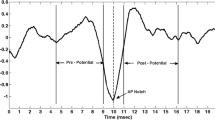Abstract
This study was conducted to investigate plausible differences in vestibular response due to lateral-impact concussion using electrovestibulography (EVestG). EVestG signals are recorded non-invasively from the external ear in response to vestibular stimuli; the EVestG signal consists of peripheral vestibulo-acoustic signals and the brainstem’s response. In this study we investigated the relationship between characteristic features of the extracted field potentials (FPs) of EVestG signals in participants with lateral-impact concussion in comparison with those of healthy controls. Twelve lateral-impact concussed participants (5 right and 6 left lateral-impact) and 12 age-and-gender-matched healthy controls were tested by EVestG. Characteristic features were extracted from the FPs during side tilt, and a leave-one-out linear discriminant analysis (LDA) classification was applied to the extracted features. The results show a clear asymmetry on the impacted side between the left and right FPs after lateral-impact compared to those from healthy controls. The LDA classification resulted in a sensitivity of 67%, specificity of 92 and 79% overall accuracy for separating lateral-impact concussed participants from controls. EVestG appears to have diagnostic potential in diagnosing lateral-impact concussion.





Similar content being viewed by others
References
Urban, J. E., Davenport, E. M., Golman, A. J., et al. (2013). Head impact exposure in youth football: High school ages 14 to 18 years and cumulative impact analysis. Annals of Biomedical Engineering, 41, 2474–2487.
Gouvier, W. D., Uddo-Crane, M., & Brown, L. M. (1988). Base rates of post-concussional symptoms. Archives of Clinical Neuropsychology, 3, 273–278.
Brown, S., Fann, J. R., & Grant, I. (1994). Postconcussional disorder: Time to acknowledge a common source of neurobehavioral morbidity. Journal of Neuropsychiatry and Clinical Neurosciences, 6, 15.
Daroff, R. B., Jankovic, J., Mazziotta, J. C., & Pomeroy, S. L. (2015). Bradley’s neurology in clinical practice e-book. London: Elsevier.
Kleiven, S. (2003). Influence of impact direction on the human head in prediction of subdural hematoma. Journal of Neurotrauma, 20, 365–379.
Zhang, L., Yang, K. H., & King, A. I. (2004). A proposed injury threshold for mild traumatic brain injury. Journal of Biomechanical Engineering, 126, 226–236.
Zhang, L., Yang, K. H., & King, A. I. (2001). Comparison of brain responses between frontal and lateral impacts by finite element modeling. Journal of Neurotrauma, 18, 21–30.
Delaney, J. S., Puni, V., & Rouah, F. (2006). Mechanisms of injury for concussions in university football, ice hockey, and soccer: A pilot study. Clinical Journal of Sport Medicine, 16, 162–165.
Lithgow, B. (2012). A methodology for detecting field potentials from the external ear canal: NEER and EVestG. Annals of Biomedical Engineering, 40, 1835–1850. https://doi.org/10.1007/s10439-012-0526-3.
Acknowledgements
This study was supported by MITACS, Neural Diagnostics Canada Ltd. and Riverview Health Centre Foundation.
Author information
Authors and Affiliations
Corresponding author
Rights and permissions
About this article
Cite this article
Suleiman, A., Lithgow, B., Mansouri, B. et al. Using EVestG Assessments for Detection of Symptomology Consequent to a Lateral-Impact Concussion. J. Med. Biol. Eng. 39, 218–223 (2019). https://doi.org/10.1007/s40846-018-0405-y
Received:
Accepted:
Published:
Issue Date:
DOI: https://doi.org/10.1007/s40846-018-0405-y




